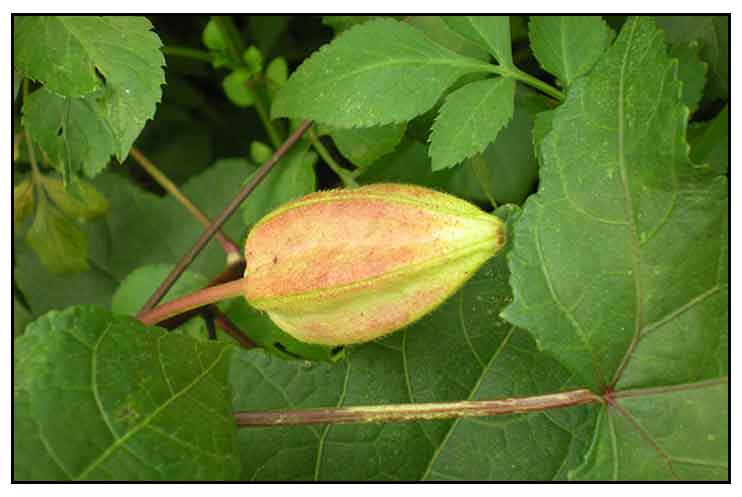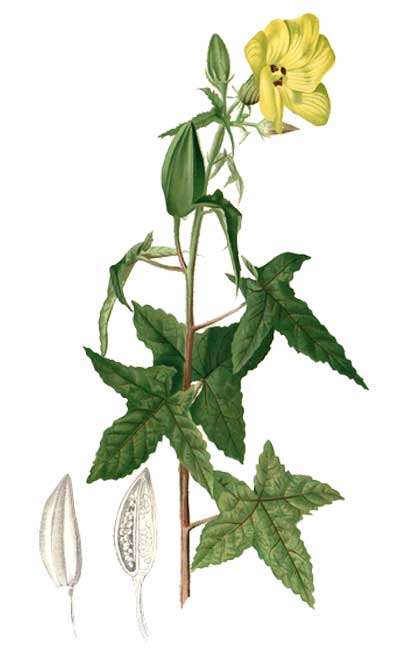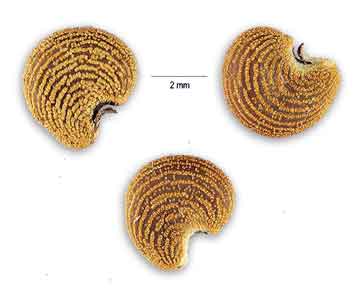|  Gen info Gen info
- Abelmoschus is a genus of about 15 species of flowering plants belonging to the Malvaceae family. (22)
Botany
Kastuli is an annual, erect and branched herb, about a meter high or less, covered with very long hairs. Leaves are orbicular-ovate to ovate, 6 to 15 centimeters long, variously angled and 3- to 5-lobed or more, pointed at the tip, broad or heart-shaped at the base, toothed at the margins. Flowers are about 10 centimeters in diameter, with yellow petals, purple at the base inside. Capsules are oblong-ovoid, 5 to 7 centimeters long, covered with long hairs and containing many musky seeds.
 Distribution Distribution
- Throughout the Philippines, in open places, grasslands and open clearings, etc., at low and medium altitudes.
- Pantropic.
Constituents
- Seeds yield a volatile oil in the seed coat.
-
Seeds yield an essential oil, 0.2 to 0.6 %, containing farnesol, palmitic acid, furfurol, acetic acid and ambrettol acid.
- Whole plant extracts yield carbohydrates, proteins, flavonoids, sterols, tannins, phenolic compounds fixed oil, and fats.
(22)
- Seeds yield moisture (11.14%), protein (2.3%), starch (13.35%), crude fiber (31.46%), fatty oils (14.5%), volatile oil (0.1-0.6%), and resin (5%)
Main constituent of seed oil is a sesquiterpene alcohol farnesol (0.12%). (22)
- Characteristic odor of the oil is attributed to the presence of a ketone, ambrettolide (0.3% in the crude oil), a lactone of ambrettolic acid (15-hydroxy-7-hexadecanoic acid).
(22)
- Seed concrete yields large amounts of fatty acid, mainly palmitic acid. Other fatty acids in crude volatile oil are octanoic acid, nonanoic acid, hexadecanoic acid, octadec-9-enoic acid, octadeca-9,12-dienoic acid, decanol, dodecanol, (E)-nerolidol, (ZE)-farnesol, (EE)farneso, decyl acetate, dodecyl acetate, among others.
(22)
- Study of seed essential oils from five samples of Hibiscus abelmoschus growing in Vietnam identified 35 components. Major constituents were (E)--2,3-dihydrofarnesyl acetate (32.9-67.3%), (EE)-farnesyl acetate (14.9-35.5%) the macrocyclic lactone ambrettolie (3.0-5.5%) and (Z,E)-farnesyl acetate (0.9-5.1%). Oils consisted of more than 90% acetates and aldehydes.
(24)
Properties
- Seeds used for isolation of fragrant components. It has a sweet flowery fragrance similar to musk.
- Seeds considered antiseptic, demulcent, diuretic, stimulant, stomachic, antispasmodic, and aphrodisiac.
- Hindus regard the seeds as cooling, tonic and carminative.
- The Arabic and Persian consider them stomachic and tonic.
Parts utilized
Seeds, roots and leaves.
Uses
Edibility
• Study suggests seed oil is comparable to groundnut oil in all parameters and is suitable for edible use. (see study below) (10)
Folkloric
• Decoction of pounded seed used as a diuretic, tonic and carminative.
• Mucilaginous decoction of root and leaves used for gonorrhea.
• Seeds used as antihysteric.
• In Malaya, leaves and roots used as poultice.
• Used for headaches, rheumatism, varicose veins, cystitis and fever.
• In Java, powder or infusion of roots used to stimulate the kidneys and intestines.
• In Bombay, paste of seeds applied for itches.
• In the West Indies, seeds are used as antispasmodic.
• In the Antilles, seeds are used for snake bites, internally and externally.
• Infusion, decoction or tincture of seeds used for nervous debility, hysteria and other nervous disorders.
• Seed are used for fevers and gonorrhea; as inhalant to relieve dryness of the throat and hoarseness.
• Powdered seeds steeped in alcohol applied to snake bites.
• In the Caribbean, used for female reproductive problems and for childbirth.
• In Egypt, seeds are chewed to relieve stomach problems, to soothe nerves and "sweeten" the breath; also considered as an aphrodisiac. Seeds made into an emulsion with milk, for skin itches.
• In Ayurveda, plant considered to pacify aggravated pitta, kapha, bronchitis, asthma, dyspepsia, coli, calculi, diarrhea, flatulence, vomiting, nervous system disorders.
• In Bangladesh, leaves and fruits seed for the treatment of snake bites: Juice from crushed leaves or fruits are administered orally and applied topically after a deep incision is made on area of snake bite. In India, the Bhil, Meena and Sahariya tribes of Rajasthan take the seed paste along with milk orally as antidote. In Sri Lanka, plant also used as antidote. (35)
Aromatherapy
• Oil used for relieving stress, fatigue, anxiety. Also, used for cramps, muscle aching, depression and nervous complaints.
Others
• Flavoring: In Arabia, use seeds to flavor coffee and soups; used for cordial properties.
• Perfumery: Oil from seeds used worldwide in perfumes.
 Studies Studies
• Myricetin / Anti-Diabetic: Myricetin, purified from the aerial part of Abelmoschus moschatus was studied in streptozotocin-induced diabetic rats. Results showed that myricetin has an ability to enhance glucose utilization to lower plasma glucose in diabetic rats lacking insulin. (1)
Myricetin extracted from A. moschatus was tested on obese Zucker rats. Results showed a dose dependent decrease in plasma glucose concentration. A Taiwanese study on STZ induced diabetic rats showed a dose-dependent decrease in glucose level and an increase in plasma beta endorphin-like immunoreactivity. The glucose lowering was mediated by activation of mu-receptors of peripheral tissues i response to increased beta-endorphin secretion. (19)
• Antimicrobial: Study on antimicrobial activity showed clear zones of inhibition against S aureus, B megaterium, S flexneri, P mirabilis, P vulgaris and Corynebacterium diphtheriae. The fraction with major antibacterial activity against C diphtheria contained terpenoid oil. (2)
• Anti-Diabetes: The study showed a high level of polyphenolic flavonoids. It also exhibited characteristics of rosiglitazone. Study concludes A moschatus is a potential useful adjuvant therapy for patients with insulin resistance and/or subjects wishing to increase insulin sensitivity. (3)
• Volatile Organic Nitrogen-Containing Constituents / Perfumery Quality
: Study yielded 58 nitrogen-containing compounds – 27 pyrazine derivatives and 12 pyridines. The odor of the basic fraction was attributed to the pyrazines, pyridines and seven thiazoles. (5)
• Antioxidant / Antibacterial / Antiproliferative: The study of seeds and leaf extracts showed AM possesses significant antioxidant activity and antibacterial activity against study strains. Hydoalcoholic extracts exhibited antiproliferative activity against two human cancer lines. (7)
• Tablet Disintegrant: Seed starch from AM was employed as a disintegrant to paracetamol tablet at various concentrations. Results showed AM seed starch can complete favorably with corn starch as disintegrant in tablet formulations. (8)
• Seed Oil / Safety Study / Edibility: After extraction of fragrance from the seed coat, seeds are flaked and extracted with hexane to yield a fatty oil. The FA composition possesses saturated, monosaturated, and polysaturated FA in ratios close to UN WHO recommendations. Acute oral toxicity study and safety evaluation tested on albino rats show it to be comparable to groundnut oil and suitable for edible use. (10)
• Hepatoprotective / Paracetamol-Induced Toxicity: Study evaluated seed extracts for hepatoprotective activity against paracetamol and ethanol induced hepatotoxicity. Results showed hepatoprotective activity of all studied extracts against paracetamol induced toxicity, with the ethanol extract showing more significant effects than the aqueous extract. (11)
• Anti-Lithiatic: Study investigated the protective effect of a hydroalcoholic extract of A. moschatus against ethylene glycol induced urolithiasis in male Wistar albino rats. Results showed reduction and prevention of growth of urinary stones. The mechanism was unknown, but may be related to increased diuresis and lowering of urinary stone forming constituents. (12)
• Improved Insulin Sensitivity: Study investigated the effect of the plant improving sensitivity in rats with insulin resistance induced by a 60% fructose diet for 6 weeks. The extract of A. moschatus displayed the characteristics of rosiglitazone (4mg/kg per day) in reducing the high HOMA-IR index. Treatment also increased post-receptor insulin signaling mediated by enhancements in insulin receptor substrate-1 associated phosphatidylinositol 3-kinase step and glucose transporter subtype 4 translocation in insulin-resistant soleus muscles. (14)
• Memory Strengthening / Seeds: Study investigated the memory strengthening effect of A. moschatus ethanolic extract of seeds. Treatment significantly improved learning and memory in mice and reversed the amnesia induced by diazepam. AM also decreased whole brain AchE and malondialdehyde content and increased the brain-reduced glutathione. Results suggest a potential candidate for improving memory, anticholinesterase and antioxidant activity, with applications in the management of dementia and Alzheimer's disease. (15)
• Diuretic / Seeds: Study investigated the diuretic activity of various extracts of A. moschatus. The alcoholic extract exhibited significant diuretic activity as shown by increased total urine volume and urine concentration of Na, K, and Cl. Furosemide was used as standard. (16)
• Antibacterial / Trypsin Inhibitors / Seeds: Study investigated the antibacterial activity associated with trypsin inhibitors (AMR-I, II, III and IV) isolated and purified from the seeds of AM. AMTI I and II showed strong activity against E. coli, P. vulgaris, B. subtilis, S. pneumoniae, B. cereus and moderate activity against K. pneumonia, P. aeruginosa, P. syringae, and S. pyogenes. Results suggest trypsin inhibitors AMTI-I and II from the may serve as candidates for the development of novel antimicrobial agents. (17)
• CNS Effects / Seeds: Study of an ethanolic seed extract of AM showed CNS effects in various behavioral models, viz. forced swim, tail suspension, light-dark box, hole-board, elevated-plus maze, locomotor, ME induced seizure, PTZ and strychnine induced convulsions. Results suggest a potential alternative source for CNS drug development. (18) Abelmoschus moschatus seed extract has shown potent antioxidant effects with protective effect on neurological disorders. It has also exhibited antidepressant, anxiolytic antiepileptic and sedative properties in animal models. It has potential as adjuvant therapy in neurological and psychiatric conditions. (23)
• Silver Nanoparticles / Antimicrobial: Study reports on the biosynthesis of stable silver nanoparticles using an aqueous extract of A. moschatus. The antimicrobial activity of the nanoparticles was demonstrated against some Gram positive and Gram negative bacteria. (20)
• Antifungal / Trypsin Inhibitors / Seeds: Study investigated the antifungal potential of trypsin inhibitors isolated from the seeds of AM on isolated pathogenic fungal strains. ATM-I and ATM-II significantly affected the growth of Candida albicans, C. tropicalis, C. glabrata, Aspergillus flavus, A. niger, and Saccharomyces cerevisiae. Fluconazole and ketoconazole were used as positive controls. Results suggest the plant derived trypsin inhibitors have excellent potential as novel antimicrobial agents. (21)
• Acute and 28-Day Repeated Dose Oral Toxicity Study / Leaves: Study evaluated the acute and 28-day repeated-dose oral toxic effects of various leaf extracts in Wistar rats. Results showed the hexane (55mg/kg) and aqueous (140mg/kg) extracts were completely nontoxic, while butanol (60mg/kg) and ethyl acetate (75mg/kg) extracts showed statistically significant changes in some hematologic parameters and in relative organ weight of kidneys in healthy Wistar rats. (25)
• Protective Effect on Developing Brain During Pre- and Post-Natal Fluoride Exposure / Seed: Study evaluated the protective effect of seed extract against sodium fluoride (NaF) induced alterations in behavior and neurochemical changes in developing brains of rats. Excessive fluoride crosses the blood brain barrier with neonatal adverse effects. Fluoride exposure increased lipid peroxidation and decreased catalase activity, and decreased body and brain weights. Study showed the vulnerability of developing brain to fluoride toxicity during development and growth and the protection provided by aqueous and ethyl acetate extracts of A. moschatus towards neurotoxicity of NaF. (26)
• Neuroprotective / Fluoride Induced Myelin Degeneration in Developing Brain / Seed: Study evaluated the protective effects of seed extract against sodium fluoride induced neurohistological changes, in particular, on myelin degeneration, cell shape size and GABA and aspartate alterations. NaF exposed rats showed decreased learning ability, increased GSH-Px activity and decreased SOD activity, along with decreased neural connections, dendritic branches, and degenerating myelin sheath. All these were reverted with aqueous and ethyl acetate extracts, with the latter showing better results than the former. Results suggest the seed extract possess neuroprotective effects against fluoride toxicity. (27)
• Antimicrobial / Dry Flowers: Study evaluated and compared the antimicrobial activity of methanol and ethanol extracts of A. moschatus dry flowers against S. aureus, E. coli and Candida albicans. Ethanolic extracts showed lower antimicrobial activity than methanolic extracts. (28)
• Antiurolithiatic / Seeds: Study evaluated the antiurolithiatic activity of A. moschatus seed extract in urolithiasis induced by surgical implantation of zinc disc in the urinary bladders of rats. Measures were dimensions of stones and levels of biomarkers in serum and urine. Supplementation of extracts caused significant improvement in glomerular filtration rate (GFR) and urinary protein excretion. Extracts prevented elevation of serum creatinine, uric acid and BUN, and also decreased deposition of calcium around the implanted disc. The higher dose of 400 mg/kg showed significant antiurolithiatic potential. The mechanism may be mediated collectively through diuretic, antioxidant, and free radical scavenging effect of the plant. (29)
• Antimotility / Antisecretory / Antidiarrheal / Seeds: Study evaluated the antidiarrheal potential of Abelmoschus moschatus seeds in different experimental models in albino Wistar rats. The hydroalcoholic extract exhibited (p<0.05, p<0.001) and dose-dependent anti-diarrheal effect with decreased number of fecal droppings on castor-oil model. The effect of 500 mg/kg extract was close to loperamide (2 mg/kg). The extract showed anti-motility effect by significantly attenuating the charcoal meal transit. It also inhibited the accumulation of intestinal fluid due to castor oil. The antidiarrheal effect was attributed to antimotility and antisecretory activities. (30)
• Antifungal / Protease Inhibitors / Seeds: Study evaluated the antifungal potential of double headed protease inhibitors (AMTIII and AMTIV) isolated from A. moschatus seeds on selected pathogenic fungal strains. In vitro, both inhibitors significantly affected the growth of Candida albicans, C. glabrata, C. tropicalis, Aspergillus flavus, A. niger, and Saccharomyces cerevisiae. Results suggest the double headed PI has potential for the development of novel antimicrobial agents against human pathogens. (31)
• Analgesic / Leaves and Seeds: Study evaluated various extracts of leaves and seeds of A. moschatus for analgesic activity in animal models. Results showed significant activity (p<0.001) in rats. Extracts of leaves at test doses of 200 and 400 mg/kbw showed more potent activity than deed extracts and standard drug.. (32)
• Polysaccharide as Colon Release Tablets / Stem: Study evaluated a novel polysaccharide extracted from the stem of A. moschatus. It was evaluated for a potential role as polymer in controlling colon-specific release of metronidazole. Cell toxicity study confirmed its safety in biological applications. Results showed the polysaccharide has potential as pharmaceutical excipient alternative to synthetic polymers. (33)
• Hemagglutinating Activity of Trypsin inhibitors / Seeds: The inhibitors, AMTI-I and AMTI-II were isolated and purified from seeds of Abelmoschus moschatus exhibited hemagglutinating activity towards different erythrocytes. Trypsin inhibitors and lectins have been shown to provide protection in plants against invading insect pests and pathogens. AMTI-I and AMTI-II possess both antitryptic and lectin activities and has potential in the agricultural front for for developing transgenics. (34)
Availability
- Wildcrafted.
- Oils and seeds in the cybermarket. |



 Distribution
Distribution


